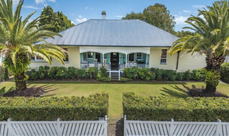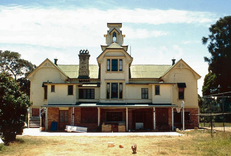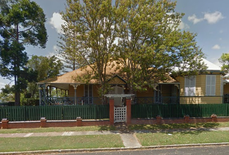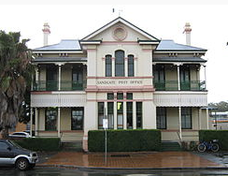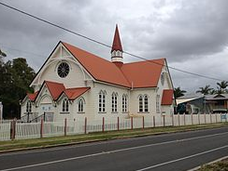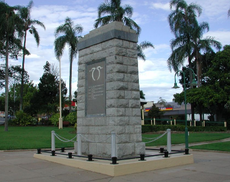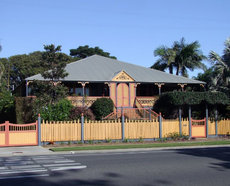Pre European Heritage
The suburb now known as Sandgate was originally known as Cabbage Tree Creek. The Aboriginals called the area Warra which means a stretch or expanse of water. For local Aboriginals, the Turrbal clan, Moreton Bay was known as Moora, meaning an open sheet of water. The Aboriginal people lived off the natural resources that the foreshore, creeks and wetlands of Moreton Bay provided. In 1823, huts were so numerous in the Shorncliffe foreshore that it was hard to count them.
Aboriginal people still keep a close relationship with the Shorncliffe-Sandgate area. It is recorded that the Turrbul people, who long inhabited the seashore, the creeks and lagoons, in what we know as the locality of Nudgee Beach to the Pine River, were a branch of the clan of the Yugarabul speaking people. This larger clan inhabited the area from North Brisbane and along the coastline of Nudgee, Sandgate to Caboolture.
In their language the local Turrbal clan called their coastal land “Warra” – “an open sheet of water”. This land we call Shorncliffe, Sandgate and Brighton. Their existence depended upon their knowledge of the seasons and their surroundings. Spears, nullas and boomerangs were used in hunting and woven nets for fishing. Most of this coastline from Nudgee Beach to the Pine River is low tidal flats and this was an area rich in sea food and the Turrbal people were able to gather shellfish and crabs and hunt for fish with the rise and the fall of the tides. This sandy beachfront was covered in mangroves and high tides covered a great deal of the beachfront which is now prime housing land. Dolphin and whales could be seen from the cliffs and dugong feed on the rich weed growing in the shallow water.
The higher land from the cliffs at Shorncliffe going north to the Bald Hills region was covered with tall trees – native eucalypts, Moreton Bay Ash, Iron Bark, Blue Gums. and the lower land with the native Melaleuca (paperbark). Inland from the coastline there is a series of fresh water lagoons where native water birds and eels flourished. Snakes, goannas and lizards concealed themselves in the undergrowth. Koala, possum, and flying fox dwelled in the trees and kangaroos and wallabies occupied the areas close around the lagoons. These lagoons provided edible ferns and water lilies and a constant supply of fresh water.
Hunting and gathering for food was a daily task and because of the climate most food could not be stored. Food was taken back to camp and cooked and consumed immediately. To give them shelter from the elements these people constructed a shelter using tree branches as poles and these were covered with the bark from the Ti-tree (the paperbark tree). Bark was also used for bedding and wrapping food for cooking.
It is recorded that the Turrbal clan camped close to the Third Lagoon and also the in the area of what we know as the Sandgate Golf Club. Another campsite was at the mouth of the Bald Hills Creek and it is recorded that a sacred burial may have existed somewhere between Bald Hills Creek and Deep Water Bend. A ceremonial site is known to have existed at the Nudgee Water Holes and oral history records a Bora ring at Bald Hills. Dinah Island at the junction of Nundah and Cabbage Trees Creeks was a sacred burial ground and the last recorded burial was for King Johnny in 1892. Red and yellow ochre, which was used for ceremonies, was gathered from a ridge at Brighton. In the coastal branch of the Turrbal tribe each woman had the two joints of one little finger taken off, when a girl.
The arrival and settlement of the Europeans’ caused a far reaching impact to the Indigenous way of life and the ecology. Free settlers began to move into the Sandgate area in 1853. They were met with strong resistance. Despite the conflict between the Aboriginals and the settlers, disease, loss of land, restriction of traditional food and water resources, a small number of Aboriginals survived. Using their local knowledge they were able to adapt to everyday life.
Aboriginal people still keep a close relationship with the Shorncliffe-Sandgate area. It is recorded that the Turrbul people, who long inhabited the seashore, the creeks and lagoons, in what we know as the locality of Nudgee Beach to the Pine River, were a branch of the clan of the Yugarabul speaking people. This larger clan inhabited the area from North Brisbane and along the coastline of Nudgee, Sandgate to Caboolture.
In their language the local Turrbal clan called their coastal land “Warra” – “an open sheet of water”. This land we call Shorncliffe, Sandgate and Brighton. Their existence depended upon their knowledge of the seasons and their surroundings. Spears, nullas and boomerangs were used in hunting and woven nets for fishing. Most of this coastline from Nudgee Beach to the Pine River is low tidal flats and this was an area rich in sea food and the Turrbal people were able to gather shellfish and crabs and hunt for fish with the rise and the fall of the tides. This sandy beachfront was covered in mangroves and high tides covered a great deal of the beachfront which is now prime housing land. Dolphin and whales could be seen from the cliffs and dugong feed on the rich weed growing in the shallow water.
The higher land from the cliffs at Shorncliffe going north to the Bald Hills region was covered with tall trees – native eucalypts, Moreton Bay Ash, Iron Bark, Blue Gums. and the lower land with the native Melaleuca (paperbark). Inland from the coastline there is a series of fresh water lagoons where native water birds and eels flourished. Snakes, goannas and lizards concealed themselves in the undergrowth. Koala, possum, and flying fox dwelled in the trees and kangaroos and wallabies occupied the areas close around the lagoons. These lagoons provided edible ferns and water lilies and a constant supply of fresh water.
Hunting and gathering for food was a daily task and because of the climate most food could not be stored. Food was taken back to camp and cooked and consumed immediately. To give them shelter from the elements these people constructed a shelter using tree branches as poles and these were covered with the bark from the Ti-tree (the paperbark tree). Bark was also used for bedding and wrapping food for cooking.
It is recorded that the Turrbal clan camped close to the Third Lagoon and also the in the area of what we know as the Sandgate Golf Club. Another campsite was at the mouth of the Bald Hills Creek and it is recorded that a sacred burial may have existed somewhere between Bald Hills Creek and Deep Water Bend. A ceremonial site is known to have existed at the Nudgee Water Holes and oral history records a Bora ring at Bald Hills. Dinah Island at the junction of Nundah and Cabbage Trees Creeks was a sacred burial ground and the last recorded burial was for King Johnny in 1892. Red and yellow ochre, which was used for ceremonies, was gathered from a ridge at Brighton. In the coastal branch of the Turrbal tribe each woman had the two joints of one little finger taken off, when a girl.
The arrival and settlement of the Europeans’ caused a far reaching impact to the Indigenous way of life and the ecology. Free settlers began to move into the Sandgate area in 1853. They were met with strong resistance. Despite the conflict between the Aboriginals and the settlers, disease, loss of land, restriction of traditional food and water resources, a small number of Aboriginals survived. Using their local knowledge they were able to adapt to everyday life.
European Heritage
Cabbage Tree Creek, that was how Sandgate was originally known, and the Aboriginals also gave it the name Warra, which means, a stretch or expanse of water. This magnificent place received it’s name from Sandgate, in the county of Kent, England. After the coming of the railway in 1882, land in Sandgate became available shortly thereafter in 1883. However, Sandgate was declared an official town, by the Governor of Queensland in 1880. One could travel from Sandgate to Brisbane Australia by train in about thirty minutes, and Sandgate quickly became a popular weekend destination. Countless people would travel from Brisbane to get away from the heat, and because Sandgate had become very well known for it’s clean beaches.
Sandgate is a very artistic town, and has been the home of a large community theater group, better known as Sandgate Theatre Incorporated. They have been performing at Sandgate Town Hall for better than fifty years, and have been continuously doing so since 1958. The Yarrageh Festival In Brisbane is the longest running community festival, and this group also performs there annually. The Sandgate Hotel was the first hotel to be built in the Sandgate community, it was established by Charles Davie in 1858. Next to come to this town was seaside cottages, which were listed in the local newspaper, and being rented out for three dollars a week, in the late 1860’s. Following this was John Baxter’s Café, which was established at Cabbage Creek in 1862. The population grew, along with the number of accommodation houses, which included Villa Marina, Belair, and Musgrave in the 1870’s. Then a soft drink manufacturing commenced starting in the 1880s.
29 April 1880: Sandgate become a borough.
For photographs of Sandgate History visit https://www.facebook.com/SandgateDistrictHistory/
Sandgate is a very artistic town, and has been the home of a large community theater group, better known as Sandgate Theatre Incorporated. They have been performing at Sandgate Town Hall for better than fifty years, and have been continuously doing so since 1958. The Yarrageh Festival In Brisbane is the longest running community festival, and this group also performs there annually. The Sandgate Hotel was the first hotel to be built in the Sandgate community, it was established by Charles Davie in 1858. Next to come to this town was seaside cottages, which were listed in the local newspaper, and being rented out for three dollars a week, in the late 1860’s. Following this was John Baxter’s Café, which was established at Cabbage Creek in 1862. The population grew, along with the number of accommodation houses, which included Villa Marina, Belair, and Musgrave in the 1870’s. Then a soft drink manufacturing commenced starting in the 1880s.
29 April 1880: Sandgate become a borough.
For photographs of Sandgate History visit https://www.facebook.com/SandgateDistrictHistory/
Interesting Historical Stories..
http://trove.nla.gov.au/newspaper/article/21261957/2520157
17 November 1927 - Banning of Shooting Endangered Birds
http://trove.nla.gov.au/newspaper/article/21261957/2520157
17 November 1927 - Banning of Shooting Endangered Birds

